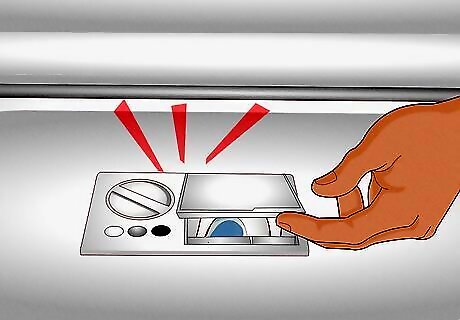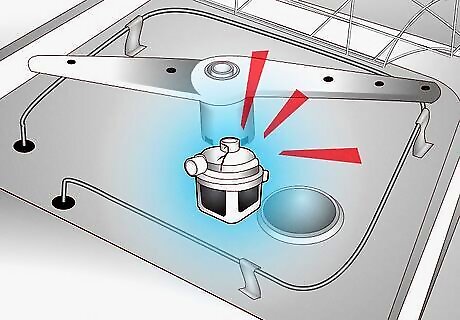
views
- If your dishwasher pod doesn't dissolve, rearrange any dishes or utensils that are blocking the detergent dispenser door and check to see if the latch is working.
- Turn up the water temperature or replace your dishwasher’s heating element if the detergent pod hasn’t fully dissolved.
- Check the sprayer arm, inlet valve, and circulation pump if the pod hasn’t dissolved and you don’t hear water moving through your dishwasher.
Damp dispenser compartment

Pods may get caught in the dispenser if it’s wet. If you put your dishwasher detergent pod in the dispenser while it’s still damp, the moisture may cause it to stick inside the compartment. Diagnosis: Look for remnants of the dishwasher pod stuck inside the detergent dispenser. The Fix: Wipe out the dispenser compartment with a damp cloth to remove detergent residue. Before you add a dishwasher pod for the next wash cycle, dry the dispenser with a cloth.
Blocked dispenser door

Dishes in front of the door may prevent the dispenser from opening. If there are tall plates or a pan handle sticking out near the dispenser door, then it may not open properly. Because the detergent pod is stuck inside, it won’t completely dissolve. Diagnosis: Check for detergent still caught in the dispenser compartment after running your dishwasher. The Fix: Load your dishwasher so taller items aren’t directly in front of the dispenser door.
Faulty dispenser

A broken or malfunctioning dispenser traps the dishwasher pod inside. If the dispenser has a broken latch or if one of the electrical connections isn’t triggering properly, the door won’t open to release the pod. Diagnosis: If the detergent pod is still inside the dispenser, then the door failed to open. Look for visible damage or cracks on the latch. If you don’t see any, then the door’s internal spring or motor may have failed. The Fix: Replace the dispenser or faulty component. Because installing the new part requires you to disassemble your dishwasher door and rewire connections, hire a professional repair person to do it for you.
Low water temperature

Cold water won’t completely dissolve a dishwasher detergent pod. Your dishwasher uses hot water to help remove food residue and dissolve the detergent fully. If your machine doesn’t pull in hot water or if the heating element is faulty, then your dishwasher may not get warm enough. Diagnosis: Check if your dishes are hot at the end of the wash cycle. If they’re cold, then the water isn’t hot enough. The Fix: Try running a wash cycle with a hotter temperature setting. If that doesn’t work, then adjust your water heater temperature between 120–150 °F (49–66 °C). If those don’t work, contact an appliance technician to replace the dishwasher’s heating element.
Clogged or faulty inlet valve

Water can’t get into your dishwasher when there are inlet valve issues. The inlet valve connects to your water supply to fill the dishwasher during a wash cycle. If debris gets in the valve screen or if the valve isn’t working properly, then there won’t be enough water to dissolve the dishwasher detergent pod. Diagnosis: If you don’t hear water entering your dishwasher when you start a cycle, it may be the inlet valve. Remove the bottom panel from your dishwasher and locate the valve connected to a supply hose on the side of the machine. Use a multimeter to test the continuity of the valve connections. If the reading doesn’t change, the valve is faulty. The Fix: Replace the inlet valve with a functioning part. Avoid trying to clean the old valve because you could cause more damage to it.
Damaged or clogged spray arms

Broken or blocked spray arms prevent water from reaching the pod. The spray arms in your dishwasher spin and distribute water throughout the machine. If they’re not working properly or if the nozzles are clogged with food, the water pressure won’t be able to dissolve the pod completely. Diagnosis: Check the rotating spray arms on the top and bottom rack for cracks or damage. Check the holes on the dispenser arm for food residue or debris clogging the parts. The Fix: First, rearrange tall dishes so they don’t stop the spray arms from spinning. Loosen the screw or bolt holding the spray arm in place, and remove it to clean the spray arm with cold water. Use a toothpick to pull out any blockages, then replace the spray arm.
Broken circulation pump

A faulty pump prevents water from moving through your dishwasher. The circulation pump brings water to the spray arms in your dishwasher to complete the wash cycle. If the pump is faulty or has a poor connection, there won’t be enough water or water pressure to dissolve the detergent pod. Diagnosis: If you don’t hear water running through your dishwasher during a wash cycle, then the pump may be faulty. The Fix: Replace the circulation pump. Because the pump is located behind your dishwasher and requires uninstalling the appliance, contact a repairperson to fix it for you.















Comments
0 comment